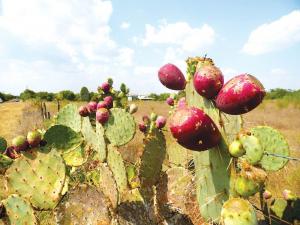2023 - Volume #47, Issue #1, Page #08
[ Sample Stories From This Issue | List of All Stories In This Issue | Print this story
| Read this issue]
Growing Edible Cactus For Food And Profit
 |
The plant is native to the Americas and grows anywhere from Connecticut to Argentina. While the prickly pear is often treated as a weed, it has many uses, from human and animal feed to natural fencing around gardens. They are hardy in drought conditions and can combat desertification, consequently improving the land itís planted on. The fruit and cactus pads offer impressive nutritional potential and are used medicinally in many regions.
The International Center for Agricultural Research in Dry Areas (ICARDA) has been promoting the crop to millions of farmers worldwide. The United Nations even considers it a food of the future for its drought tolerance, ability to boost soil health, and quick growing time to maturity.
Both the prickly pear cactiís fruits and pads (known as nopales) are edible. The pads are a common ingredient in many Mexican recipes, including curries, salads, and stir-fries. And despite their prickly exterior, the cactiís young pads work as a nutritious animal feed that can supplement up to 40 percent of a cattleís diet and 100 percent of the diet of sheep and goats.
This naturally abrasive plant also offers potential as living fencing. South Carolinaís Wild Hope Farm uses it as a fencing system to keep deer out of the vegetable garden. Not only does a cactus fence require minimal maintenance once itís established, but the fruit and young pads can be continually harvested for profit. The farm sold $15,000 in fruit from its fence in 2021 alone. Additionally, the cactiís flowers attract beneficial pollinators to the garden plants to improve their production.
One limitation for commercial success with cacti fruits is the hair-like spines (known as glochids) that grow over them.
Wild Hope Farm has invented a technique for removing the spines, making the fruit easier to harvest and handle. The farm workers place the fruit on a wooden frame with a metal screen that acts like a sieve. Itís attached by chains on all four corners and suspended above the ground so the workers can jostle the frame and fruit back and forth. As two jostle the frame, a third burns off the spines with a blow torch. The final result? Cactus fruit thatís easier and safer to handle.
While it may take effort to scale up this technique to make it work commercially, Wild Hope Farm and others like them are paving the way forward for more profitable cactus production.
Contact: FARM SHOW Followup, Wild Hope Farm, 575 Wild Hope Farm Road, Chester, S.C. 29706 (ph 803-816-2633; www.wildhopefarm.com).

Click here to download page story appeared in.

Click here to read entire issue
To read the rest of this story, download this issue below or click here to register with your account number.




